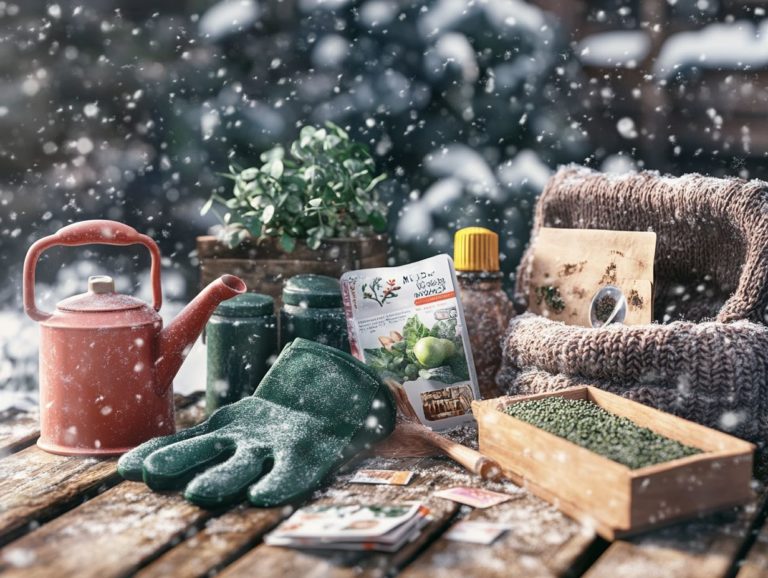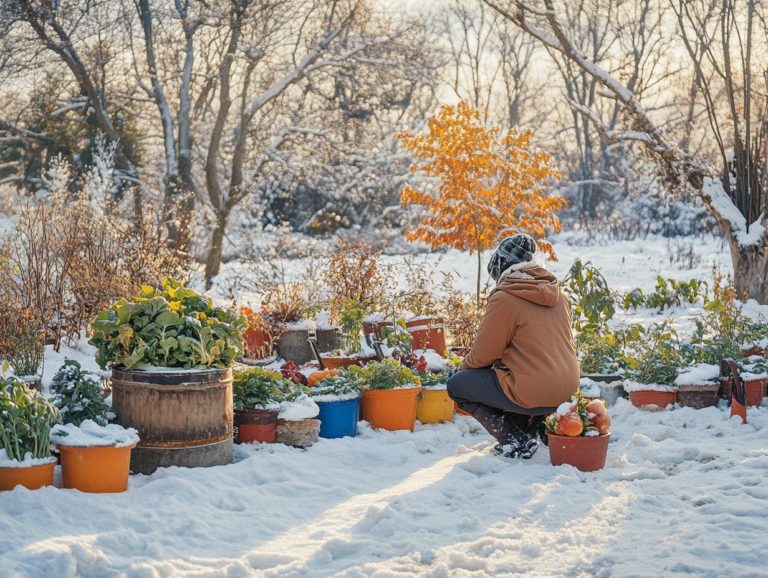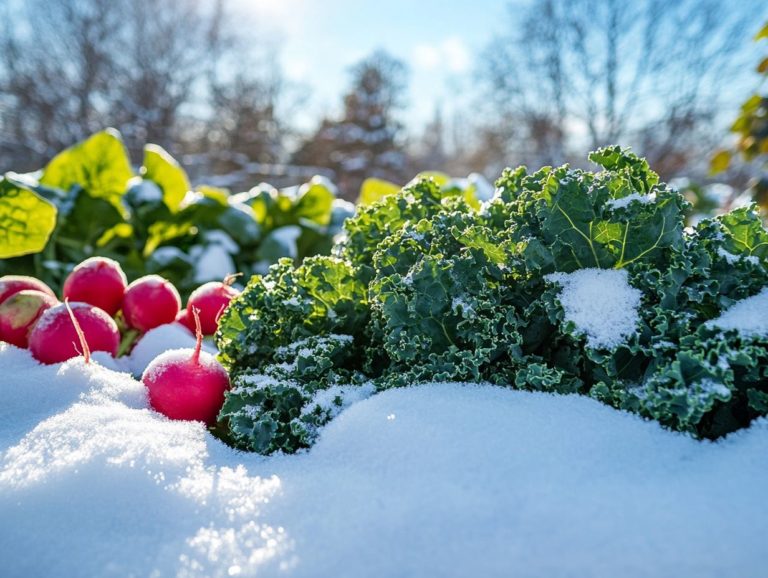Maximizing Yield: Top Winter Gardening Techniques
Winter gardening might feel a bit intimidating, but it actually presents a wonderful opportunity for you to grow fresh produce and vibrant plants even during the colder months.
This article will delve into the many benefits of winter gardening, guiding you through essential preparation steps and highlighting the best plants to nurture when temperatures dip. You ll also discover effective techniques to protect your garden from frost and maximize your yield, allowing you to relish the fruits of your labor all winter long.
Get ready to turn your garden into a vibrant winter wonderland!
Contents
- Key Takeaways:
- Benefits of Winter Gardening
- Preparing Your Garden for Winter
- Best Plants for Winter Gardening
- Protecting Your Plants from Frost and Snow
- Maximizing Yield in Winter Gardening
- Frequently Asked Questions
- What is the best way to maximize yield in a winter garden with sustainable gardening techniques?
- Why is crop rotation important in winter gardening for soil health?
- What are some good companion plants for winter gardening, including hardy vegetables?
- How can using cold frames and hoop houses increase yield in a winter garden?
- Are there any specific winter gardening techniques for root vegetables and season extension?
- Can I use a combination of gardening methods to maximize yield in a winter garden?
Key Takeaways:
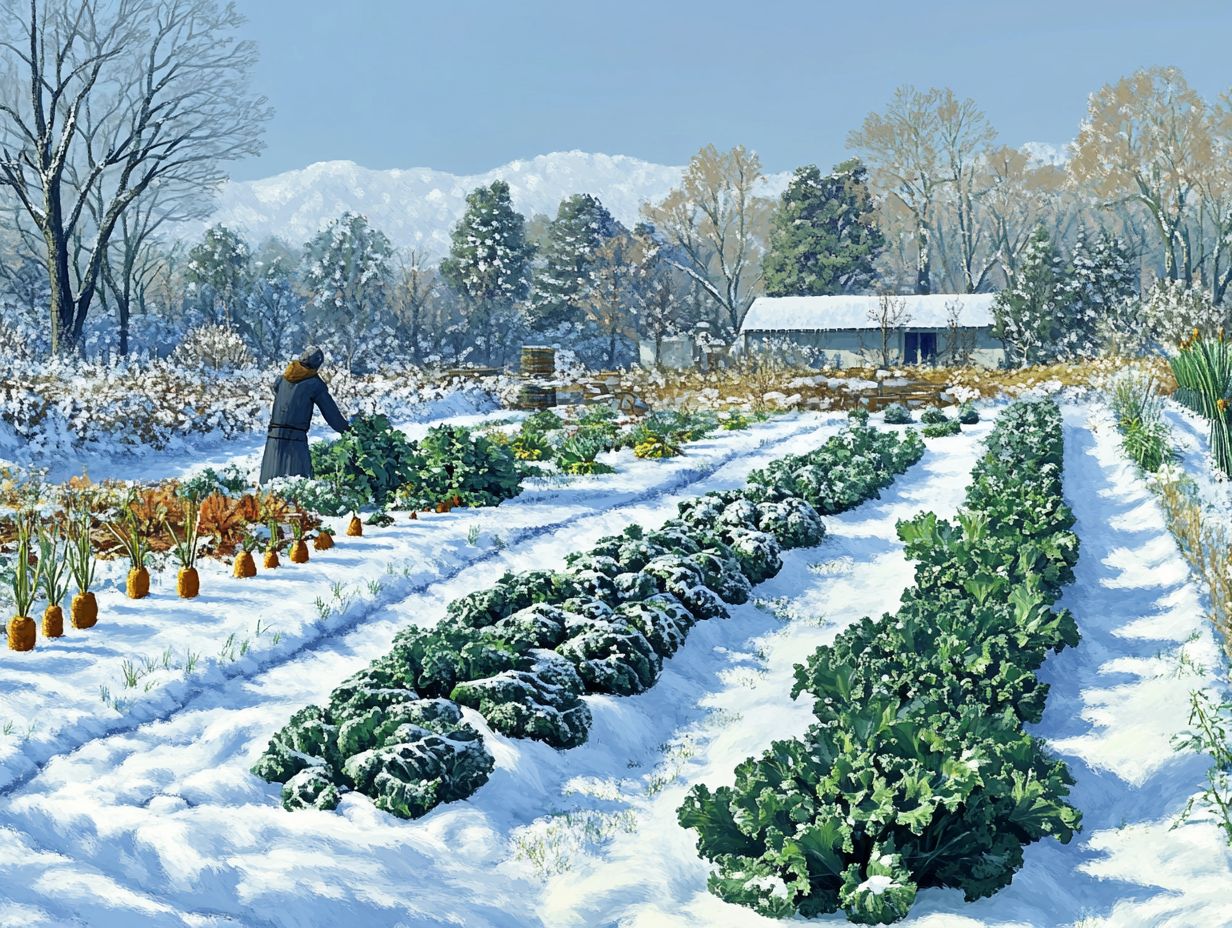
- Discover the benefits of winter gardening, such as providing fresh produce during the off-season and boosting mental health during the colder months.
- Prepare your garden for winter by following essential steps, such as cleaning up dead plants, mulching, and covering delicate plants.
- Maximize your yield in winter gardening by choosing appropriate plants, protecting them from frost and snow, and using techniques like cold frames and row covers.
What is Winter Gardening?
Winter gardening is an exceptional method that gives you the power to cultivate a diverse array of plants, even in the chill of winter. By employing techniques such as cold frames, hoop houses, and row covers, you can effectively extend your growing season and keep your garden flourishing.
This practice enhances the health of your soil and encourages the growth of resilient vegetables like kale, spinach, and carrots perfect for gardeners in areas like North Idaho and Utah.
By utilizing cold-weather gardening techniques, you can establish a microclimate a small area with a different climate than the surrounding area that shields your plants from frost and harsh winds, resulting in healthier and more bountiful harvests.
Tools like cold frames and hoop houses are your allies in trapping heat and sunlight, allowing you to plant earlier and enjoy prolonged harvests. As a newcomer to this rewarding endeavor, you might discover valuable insights through local gardening clubs or online forums focused on winter gardening tips. These resources can help you uncover an even wider variety of vegetables that thrive in cooler temperatures, enhancing your gardening experience.
Benefits of Winter Gardening
Engaging in winter gardening offers a wealth of benefits that elevate your gardening experience while promoting sustainable practices. It allows you to enjoy fresh produce during the colder months and effectively extends your growing season, enhancing both your cooking skills and your connection to nature.
Why Garden in the Winter?
Gardening in the winter may feel a bit unconventional, but it presents a unique opportunity to cultivate fresh produce and culinary herbs that can elevate your meals, making it a worthwhile pursuit for any gardening enthusiast.
By embracing winter gardening, you can delve into a variety of vegetable strains specifically bred for cooler climates, such as kale, spinach, and root vegetables, which flourish even in lower temperatures. This distinctive practice can seamlessly blend into your broader gardening philosophy, promoting sustainability and self-sufficiency. The joy of harvesting vibrant greens and hearty roots during a season typically marked by dormancy offers a rewarding sense of accomplishment and a deeper connection to nature.
Not only does it extend your growing season, but it also sparks culinary creativity, transforming winter meals into delightful feasts brimming with fresh flavors.
Preparing Your Garden for Winter
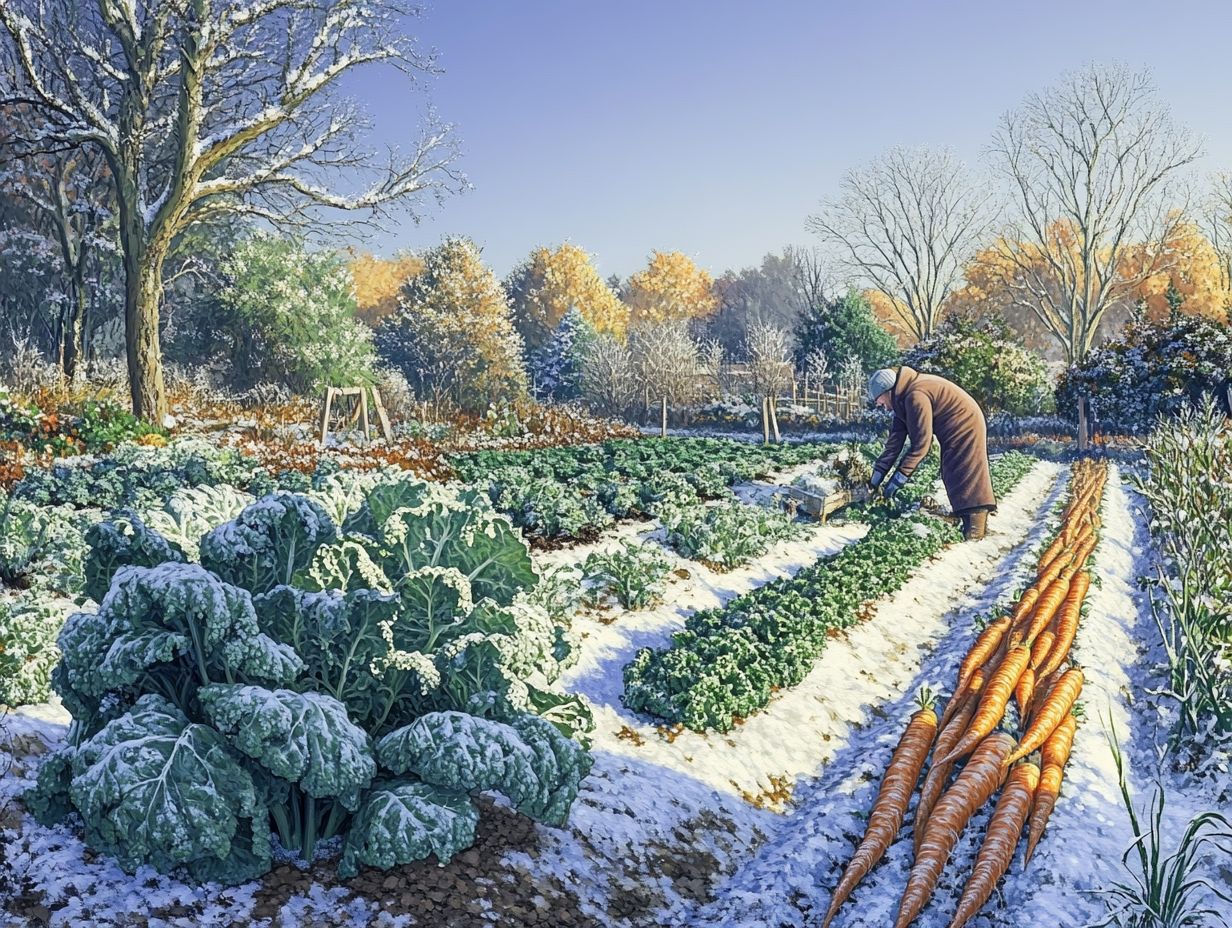
Preparing your garden for winter is crucial for maintaining the health of your plants and soil. This process involves a keen approach to garden planning and the application of effective gardening techniques that not only protect against frost but also enhance soil health.
By taking these steps, you re setting the stage for a vibrant garden come spring.
Essential Steps for Winterizing Your Garden
Winterizing your garden involves essential steps that elevate your gardening game. Utilize cold frames and row covers to shield your crops from harsh weather. This preparation ensures your vegetable garden thrives even during the cold months.
Proper preparation protects your plants and boosts their resilience against winter stresses. Creating warm spots in your garden can significantly benefit sensitive crops. Position taller plants as windbreaks or use fences and walls to create sheltered spots that enhance growth.
You should also consider methods like mulching. This conserves moisture and enriches the soil as it breaks down. Choosing the right tools, such as row covers, helps retain warmth while still allowing light and moisture to penetrate key ingredients for maintaining plant health.
Throughout this process, it s crucial to avoid common pitfalls. Neglecting drainage can lead to root rot, and failing to protect tender plants during winter can spell disaster. By steering clear of these missteps, you ll set your garden up for a successful transition into spring.
Best Plants for Winter Gardening
Choosing the best plants for winter gardening is essential for maximizing your yield. For optimal results, consider incorporating a range of cold-hardy crops and learning about winter planting: timing and techniques such as kale, carrots, and microgreens.
These resilient varieties flourish in cooler temperatures, ensuring a steady supply of organic vegetables throughout the season.
Types of Plants That Thrive in Winter
Cold-hardy crops like garlic, broccoli, and Brussels sprouts are among the best vegetable varieties that not only survive but thrive during winter. By using specific gardening methods, including frost protection and careful planning, you can maximize your winter gardening efforts.
These tough vegetables are not just resilient against low temperatures; they also become surprisingly flavorful when harvested after a frost. Use techniques like row covers and cold frames to create warm spots, providing these plants with the warmth they need to keep growing.
You should also consider container gardening as an effective strategy. This method allows you to easily move your plants and protect them from harsh winds.
With the right care ensuring adequate moisture and thoughtful soil preparation, winter gardening can yield remarkable results. For those interested in maximizing their harvest, following specific tips for growing microgreens in winter will help you enjoy hearty produce throughout the colder months and significantly extend your growing season.
Protecting Your Plants from Frost and Snow
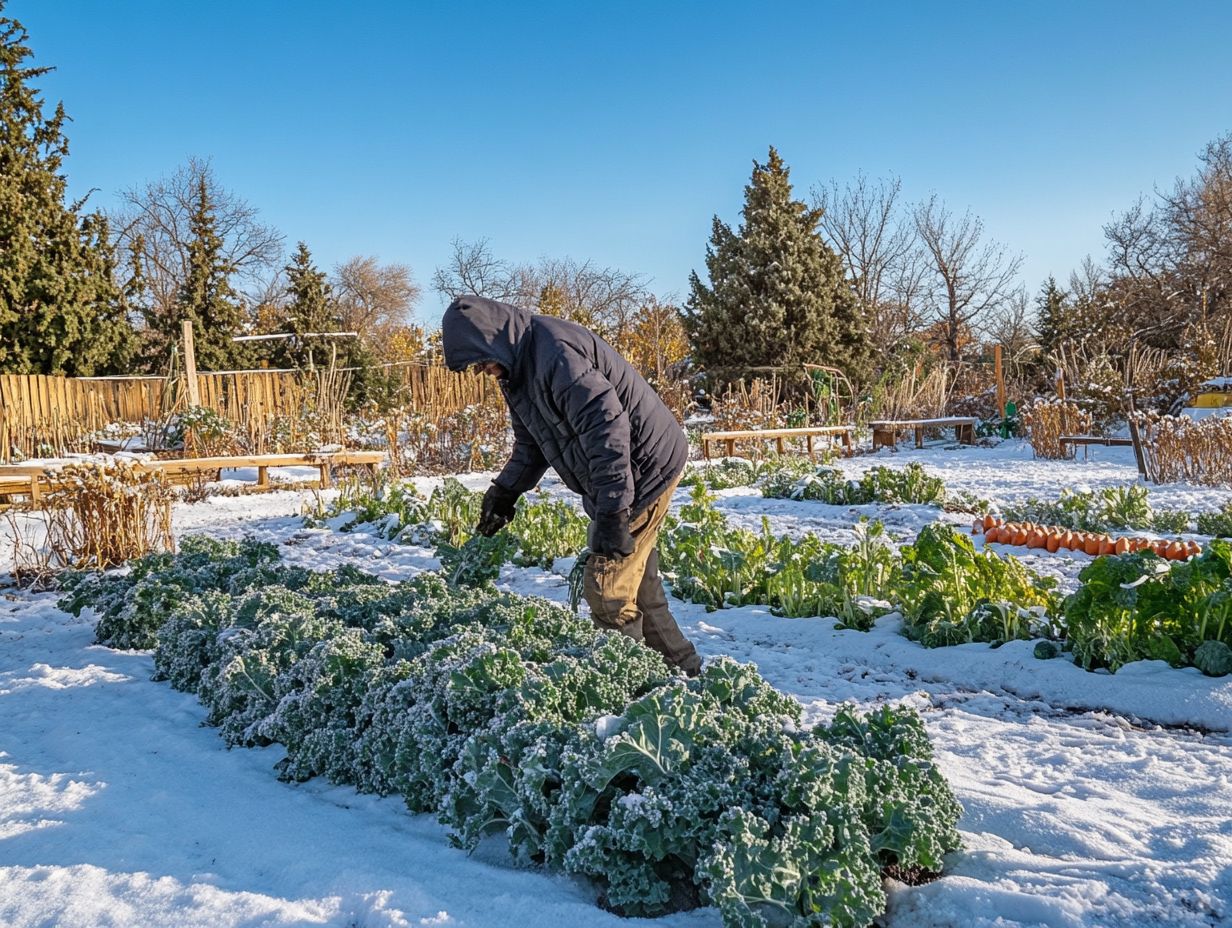
Protecting your plants from frost and snow is crucial for their survival during winter gardening. By using effective techniques like row covers and cold frames, you can safeguard your crops against harsh weather conditions.
Effective Techniques for Protecting Your Garden
Implementing effective frost protection techniques is vital for your winter gardening efforts. For those looking to improve their skills, exploring winter gardening tips for enthusiasts can help you focus on methods that enhance soil health and provide shelter from the cold, ensuring your gardening efforts truly pay off.
By incorporating mulch around your plants, you can retain soil moisture while insulating the roots from harsh winter temperatures. Explore the warm spots in your garden; certain areas may be warmer or more sheltered, allowing for strategic planting that extends the growing season for your delicate crops.
Using row covers and cold frames can dramatically boost your plants’ resilience against freezing conditions. To ensure success, follow the key steps for preparing your garden for winter and incorporate hardy varieties that thrive in cooler months to keep your garden productive throughout winter.
Maximizing Yield in Winter Gardening
Maximizing yield in winter gardening requires strategic planning and the execution of effective gardening techniques. By incorporating tips for sustainable winter gardening, you can ensure that your vegetable harvests remain bountiful and productive, even in the chill of the season.
Tips for Optimizing Your Harvest
Optimizing your winter garden harvest demands a thoughtful approach to choosing plants, a keen eye on soil health, and the application of trusted gardening techniques. For overcoming winter gardening challenges, your efforts can yield great results even amidst seasonal obstacles.
To achieve the best results, start by selecting winter-hardy vegetable varieties such as kale, carrots, and Brussels sprouts. These resilient options tolerate lower temperatures while packing in extra flavor and nutrients.
Proper soil preparation is key. Enriching your soil with organic compost enhances fertility and improves moisture retention, creating a nurturing environment for your plants.
Regular maintenance techniques, like mulching, help regulate soil temperature and curtail weed growth. This makes your gardening efforts more efficient.
Don’t wait check plant health regularly by looking for pests and signs of stress. Taking action to adjust your care practices in response to shifting weather such as providing extra protection during unexpected frosts or ensuring adequate watering during dry spells will significantly enhance your overall productivity.
Frequently Asked Questions

What is the best way to maximize yield in a winter garden with sustainable gardening techniques?
The best way to maximize yield in a winter garden is to use techniques such as crop rotation, companion planting, and utilizing cold frames or hoop houses. For more information on these methods, check out the best cold-weather gardening techniques to extend the growing season.
Why is crop rotation important in winter gardening for soil health?
Crop rotation is important in winter gardening because it helps prevent soil depletion and disease buildup, resulting in healthier plants and higher yields.
What are some good companion plants for winter gardening, including hardy vegetables?
Some good companion plants for winter gardening include carrots and onions, broccoli and lettuce, and kale and beets. These plants work well together and can help improve yield as well as deter pests.
How can using cold frames and hoop houses increase yield in a winter garden?
Cold frames create a microclimate that can protect plants from harsh winter conditions and extend the growing season. By using cold frames, you can continue to grow and harvest crops well into the colder months, increasing your overall yield.
Are there any specific winter gardening techniques for root vegetables and season extension?
Yes, there are several techniques for maximizing yield with root vegetables in a winter garden. These include using deep mulching, hilling up soil, and planting in raised beds with good drainage.
Can I use a combination of gardening methods to maximize yield in a winter garden?
Absolutely! Using a combination of techniques such as crop rotation, companion planting, cold frames, and utilizing vertical gardening in winter can greatly increase your yield in a winter garden.
Start your winter gardening journey today and watch your harvest thrive!


